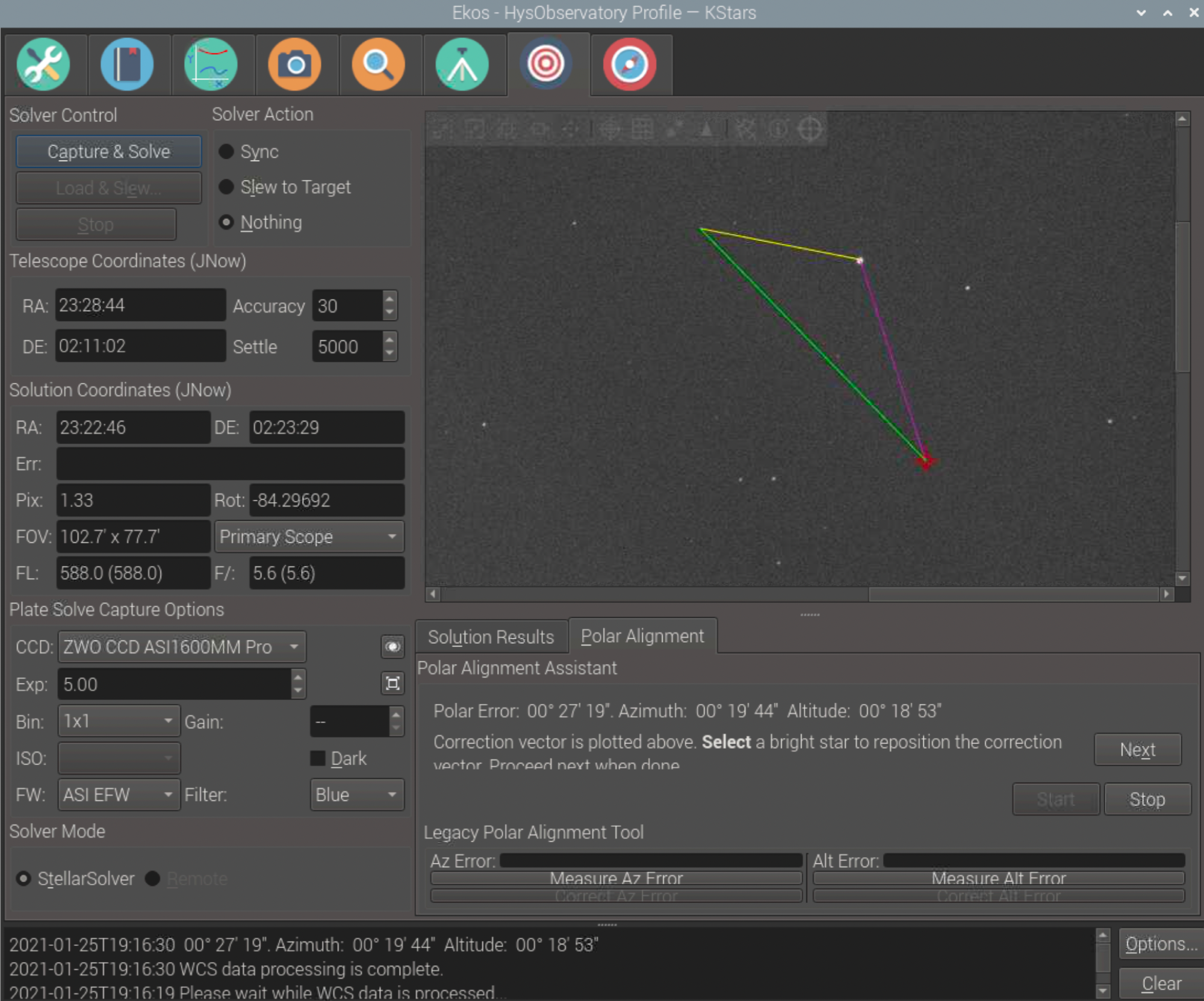×
INDI Library v2.0.7 is Released (01 Apr 2024)
Bi-monthly release with minor bug fixes and improvements
Re:New Polar Alignment Scheme and Features
- Peter Sütterlin
-

- Offline
- Supernova Explorer
-

- Posts: 1009
- Thank you received: 133
Replied by Peter Sütterlin on topic New Polar Alignment Scheme and Features
Sorry for the silence. No news here, the clouds are back, and the road to up above the clouds is closed due to landslides 
Your explanation of the deviation seems very sound! I agree that the test was really a challenge, especially as my compass is in the observatory, and not here . But such extreme settings often help to pinpoint problems.
. But such extreme settings often help to pinpoint problems.
I absolutely agree that it's not really needed to change the plotting. If one gets such large corrections an iteration is needed anyhow, and that one will have better matched movement paths. So all fine for now. I'll pester you again once I find more silly ideas
Your explanation of the deviation seems very sound! I agree that the test was really a challenge, especially as my compass is in the observatory, and not here
I absolutely agree that it's not really needed to change the plotting. If one gets such large corrections an iteration is needed anyhow, and that one will have better matched movement paths. So all fine for now. I'll pester you again once I find more silly ideas
3 years 3 months ago
#66374
The topic has been locked.
- Hy Murveit
-
 Topic Author
Topic Author
- Away
- Administrator
-

- Posts: 1222
- Thank you received: 565
Replied by Hy Murveit on topic New Polar Alignment Scheme and Features
While testing some new polar alignment code this evening, I came across an interesting screenshot I wanted to share.
I positioned the telescope to point just North of the Equator, and just West of the Meridian (and I'm in the Northern Hemisphere).
I ran polar alignment with two 30-degree slews going West. I had intentionally messed up my polar alignment by about 1/2 degree.
Looking at the log, spot of the 3rd PAA image is azimuth 253.934 altitude 23.5716.
What I wanted to point out, is that the correction triangle is telling the user to use the altitude knob to move the star along the yellow line seemingly AWAY from the ultimate target. When the user reaches the end of the yellow line, then adjusting the azimuth knob would bring the star along the green line to the target. It turns out that there are spots in the sky where azimuth and altitude corrections at the pole map to surprising directions like this. This is the reason I originally came up with the idea of introducing a correction triangle.
In fact, I followed the directions given, and the resulting correction worked fine. I verified this by re-checking polar alignment at the pole.
Hy
I positioned the telescope to point just North of the Equator, and just West of the Meridian (and I'm in the Northern Hemisphere).
I ran polar alignment with two 30-degree slews going West. I had intentionally messed up my polar alignment by about 1/2 degree.
Looking at the log, spot of the 3rd PAA image is azimuth 253.934 altitude 23.5716.
What I wanted to point out, is that the correction triangle is telling the user to use the altitude knob to move the star along the yellow line seemingly AWAY from the ultimate target. When the user reaches the end of the yellow line, then adjusting the azimuth knob would bring the star along the green line to the target. It turns out that there are spots in the sky where azimuth and altitude corrections at the pole map to surprising directions like this. This is the reason I originally came up with the idea of introducing a correction triangle.
In fact, I followed the directions given, and the resulting correction worked fine. I verified this by re-checking polar alignment at the pole.
Hy
3 years 3 months ago
#66502
The topic has been locked.
- Jasem Mutlaq
-

- Online
- Administrator
-

Replied by Jasem Mutlaq on topic New Polar Alignment Scheme and Features
Bravo Hy! Great work on the PAA tool! I wonder if this could be remotely related to why the direction for the correction vector was reversed for some users before you introduced the triangle?
3 years 3 months ago
#66512
The topic has been locked.
Replied by simont on topic New Polar Alignment Scheme and Features
Just a side question. Is the alignment done on the real or refracted pole? I ask because last night I ended up with a really good polar alignment (19" error in azimuth and 17" in altitude), I saw no DEC drift, phd Guiding Assistant reported 0-0.1' of polar alignment error, but I still saw about 1"/min drift in RA when pointing near the meridian and at 40-45* altitude. To my understanding it may (or may not?) be due to refractive effects (I checked with some simulators and the residual alignment error alone would not account for that drift). Any suggestion on that? Thanks
3 years 2 months ago
#66648
The topic has been locked.
- Peter Sütterlin
-

- Offline
- Supernova Explorer
-

- Posts: 1009
- Thank you received: 133
Replied by Peter Sütterlin on topic New Polar Alignment Scheme and Features
Difficult question, especially for the new PA scheme.
If you align 'the old way' looking at the pole, you'll align to the refracted pole (AFAIK there's no code in to compensate refraction). Depending on your latitude that might not be much difference anyhow, but it could explain why you get good alignment but still see drift at meridian/zenith.
In principle, if you use the new code with low declination locations, like drift align it should align to the real (unrefracted) pole and give you no drift at meridian/zenith, but a larger error if you verify the PA at the pole, and possibly lead to image rotation when imaging at the pole.
At least, that's (my) theory about it. I intend to verify it, but so far had no chance to do it
If you align 'the old way' looking at the pole, you'll align to the refracted pole (AFAIK there's no code in to compensate refraction). Depending on your latitude that might not be much difference anyhow, but it could explain why you get good alignment but still see drift at meridian/zenith.
In principle, if you use the new code with low declination locations, like drift align it should align to the real (unrefracted) pole and give you no drift at meridian/zenith, but a larger error if you verify the PA at the pole, and possibly lead to image rotation when imaging at the pole.
At least, that's (my) theory about it. I intend to verify it, but so far had no chance to do it
3 years 2 months ago
#66657
The topic has been locked.
Replied by Ken Self on topic New Polar Alignment Scheme and Features
Good article on the subject here: canburytech.net/DriftAlign/DriftAlign_3.html
3 years 2 months ago
#66659
The topic has been locked.
Replied by simont on topic New Polar Alignment Scheme and Features
Yes, it’s from that article that my question arise. I also used the attached spreadsheet to check the drift induced by alignment error vs refraction.
3 years 2 months ago
#66660
The topic has been locked.
Replied by ouioui01 on topic New Polar Alignment Scheme and Features
3 years 2 months ago
#66664
The topic has been locked.
- Hy Murveit
-
 Topic Author
Topic Author
- Away
- Administrator
-

- Posts: 1222
- Thank you received: 565
Replied by Hy Murveit on topic New Polar Alignment Scheme and Features
That setting isn't used in the polar alignment routine.
Hy
Hy
3 years 2 months ago
#66668
The topic has been locked.
- Jasem Mutlaq
-

- Online
- Administrator
-

Replied by Jasem Mutlaq on topic New Polar Alignment Scheme and Features
It's used implicitly whenever you perform Equatorial to Horizontal conversion, the refraction is taken into account.
3 years 2 months ago
#66671
The topic has been locked.
Replied by simont on topic New Polar Alignment Scheme and Features
uhm, it's still not clear to me if the end result of this conversions is that the alignment is done to the real or refracted pole. If any refraction effect is accounted for, I suppose that we are aligning to the real pole, since each image is put back to its unrefracted position and their center of rotation is aligned to the real pole. Instead, If no correction is applied, then the images rotate around the diffracted center of rotation, but now to which pole it is aligned?
3 years 2 months ago
#66674
The topic has been locked.
- Peter Sütterlin
-

- Offline
- Supernova Explorer
-

- Posts: 1009
- Thank you received: 133
Replied by Peter Sütterlin on topic New Polar Alignment Scheme and Features
Hmm, maybe turn the question around and ask "Which pole do you want to align to?"
If you want to align to the refracted pole, switch off the refraction correction and PA close to the pole.
If you want the real one, PA with low declination and high altitude, or use drift align.
A very quick test is to run PA at the pole, once with correction turned off, once with correction on, and compare the reported error.
If you want to align to the refracted pole, switch off the refraction correction and PA close to the pole.
If you want the real one, PA with low declination and high altitude, or use drift align.
A very quick test is to run PA at the pole, once with correction turned off, once with correction on, and compare the reported error.
3 years 2 months ago
#66677
The topic has been locked.
Time to create page: 1.004 seconds
© 2003-2022 by INDI Library. All rights reserved.


